Florida’s Snakes: Debunking Myths and Misconceptions – Listen to this article on the player below
Unveiling the Truth: Separating Fact from Fiction
Without doubt, snakes have long been the subject of misconceptions, often leading to unnecessary fear and hostility towards these creatures. Public opinion frequently errs on the side of fear, painting snakes as venomous beings lurking in the shadows, waiting for an opportune moment to strike. However, this image, riddled with fallacy, harms not only the easy camaraderie we could share with these misunderstood creatures but their very existence too. To truly coexist, it is imperative that we peel away these misconceptions and unfurl the genuine, often fascinating reality about Florida’s snakes.
Let us take the first step towards dispelling these untruths by countering the most prevalent myth – that all snakes are venomous. In fact, the antithesis holds true; of the 50 or so snake species found in Florida, only 6 are venomous. This means the bulk of snakes that one may chance upon in the Sunshine State are of the non-venomous variety; fascinating creatures that pose no significant threat to humans.
The Misconception of Aggression
“Slithering beasts, always ready to strike,” some whisper. Yet, this is a far cry from reality. Florida’s snakes are more likely to slink away at the sight of humans, choosing flight over fight. They are not the aggressive hunters they’re made out to be; rather, they bear more resemblance to covert defenders, standing their ground only if they perceive a threat or when cornered.
Size and Threat – A Misguided Perception
Another preconceived notion is that a snake’s degree of danger is directly proportional to its size. However, size is not an indicator of threat, as venomous snakes can come in all sizes. To adhere to this baseless speculation is to invite unnecessary peril into one’s life.
The ‘Deadly’ Misnomer
Perhaps most importantly, not every snakebite is a death sentence. While any venomous bite should be treated as a medical emergency, Florida’s venomous snake bites are rarely fatal with prompt and proper medical care. Though unpleasant, the result is typically less catastrophic than most imagine.
Now that the veil of misinformation has started to lift, it is evident that the snakes of Florida are more misunderstood than malicious, more intriguing than threatening, and more deserving of our respect and understanding than our irrational fear. By challenging these common misconceptions, we pave the path towards coexisting harmoniously with these crucial actors of Florida’s rich ecological theater.
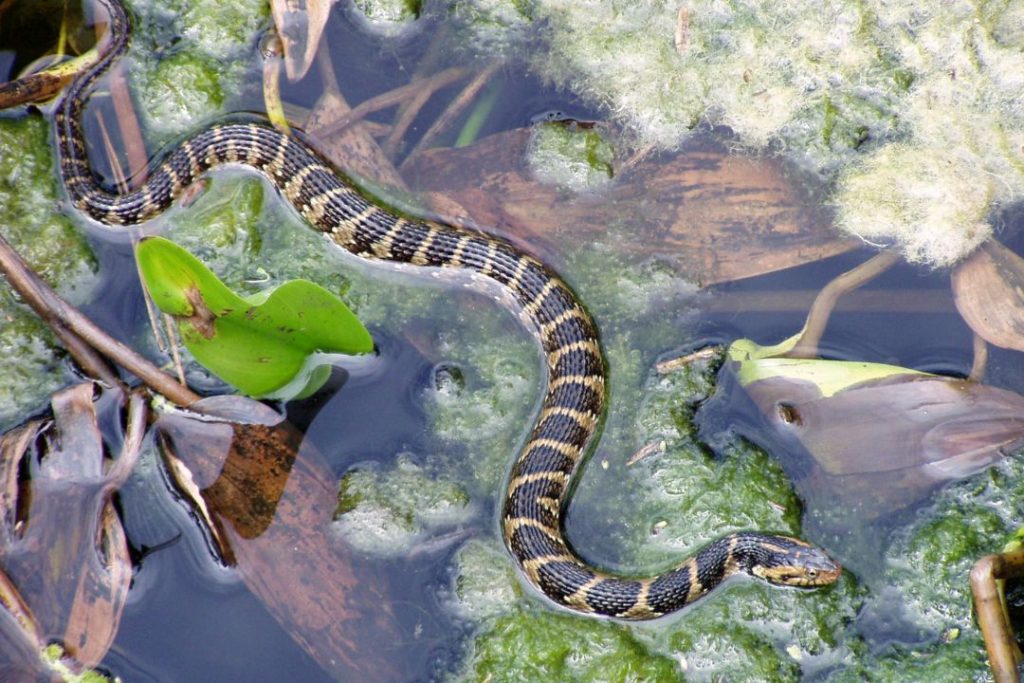
Danger or Delight? Understanding the Behavior of Florida’s Snakes
Whether regarded as a symbol of trepidation or a fascinating emblem of nature’s breathtaking diversity, the behavior of Florida’s snakes is robust with captivating intrigue. Yet, far from vindictive terror of folktales, or the calculated villains we conjure in our minds, these serpents are primarily non-confrontational, reactive beings, only engaging when they feel threatened.
Defensive, Not Offensive
Rather than the offensive predators, many fearfully assume them to be; Florida’s snakes are chiefly defensive creatures. Yet, it is in this defensive strategy that our fears and misunderstandings often lie. Imagine yourself adrift in an unfathomable sea of tall grass, under the constant threat of predators; such is the life of a snake. Hence, the ‘aggression’ often attributed to them is merely a product of their instinctual need for self-preservation.
Evasion over Engagement
A meticulously designed network of sensory adaptations allows snakes to react accordingly to potential threats. Interestingly, their initial impulse is often to retreat rather than attack. Frequently, snakes prefer the art of evasion over engagement; a balletic performance of withdrawing gracefully into the underbrush with the aim of ensuring their survival. The striking imagery of a coiled serpent ready to strike is quite the rpend; it is a depiction, more often than not, of desperation rather than predatory prerogative.
Curious Characters
Despite their seemingly clandestine nature, snakes are creatures of profound curiosity. This curiosity is often misinterpreted as a pursuit, leading to unnecessary fear. Snakes might track a human’s path to investigate a new scent or to sunbathe on a warm path recently tread upon. Such behaviors do not signify aggression; rather, they highlight the snake’s innate inquisitiveness.
Solitary Survivalists
Encounters with these solitary survivalists are usually products of our intrusion into their territory rather than predatory expeditions on their part. Wildly misinterpreted as marauders, snakes more accurately represent the stoic survivalists of the Serpentus order; their behaviors are dictated by survival instinct rather than territorial domination.
Their primary objective: to lead a life uninterrupted by predators and to successfully procreate. They are not aware of the narratives spun about them by human imagination; to them, we are but another giant beast best avoided for survival’s sake.
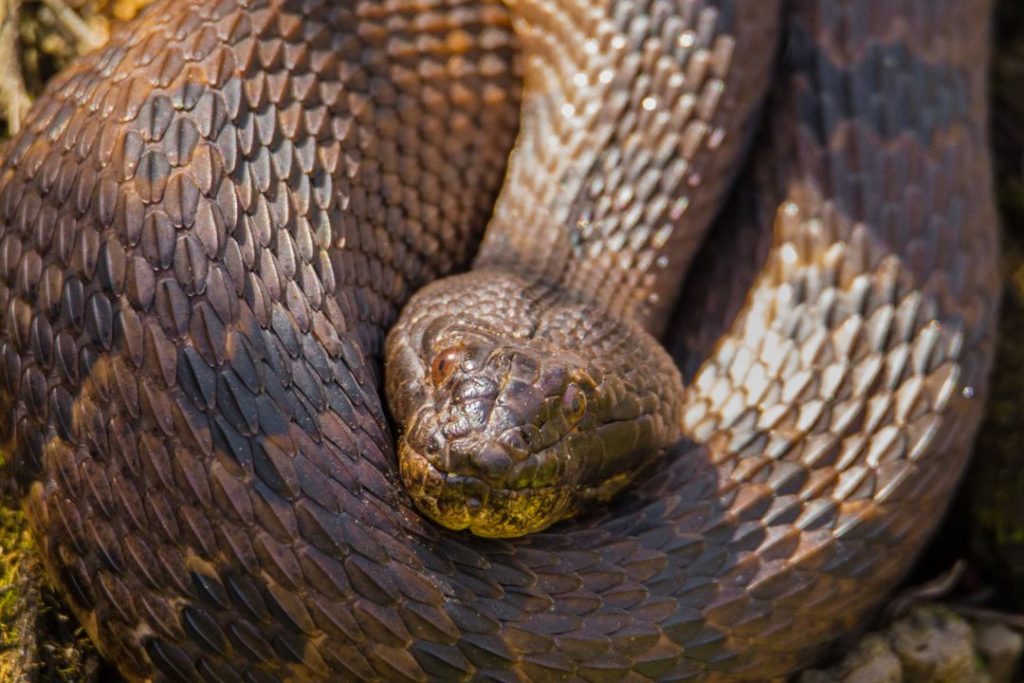
Educate, Don’t Eliminate: The Ecological Importance of Florida’s Snakes
Often, in the illusionary dance twixt fear and misunderstanding, we humans have failed to comprehend the crucial contribution of Florida’s snakes to the intricate pas de deux of our ecosystem. These serpines are not mere creatures of shadows and fear; they are, in effect, critical whirling cogs in the complex clockwork of nature that maintain our delicate ecological equilibrium.
Nature’s Sophisticated Pest Control
As creatures of a certain primal aesthetic, snakes thrive on a meat-based diet, their forte being rodents. A single snake embellishes its diet with dozens of pesky pests each year; securing, as you might, a double-edged advantage. The steady consumption of rats and mice serves a dual purpose; lessening the number of destructive pests that can harm crops and homes, and limiting the spread of diseases often transmitted by these creatures; a comely boon provided by our slithering friends.
Prey Becomes Predator: An Elegant Balance
Yet, the enigmatic ballet of the ecosystem doesn’t end there. In an elegant waltz of nature’s balance, snakes themselves form an essential part of the menu of larger predators. Herons, hawks, and raccoons, among others, feast upon these beautiful labyrinths of scales and muscle; a reminder of the endless cycle of life and death that shapes our world.
Guardians of Nutrient Cycling
Furthermore, snakes’ role transcends mere predator and prey. They take part in the intricate symphony of nutrient cycling, for when they return to the earth after death, their bodies decompose, releasing invaluable nutrients back into the soil—a poetic homage to the circle of life.
Role as Indicator Species
And then beyond what meets the dramatic eyes of nature’s theatre, snakes also serve as heralds of environmental health – known as ‘indicator species’. Changes in snake populations can often be a dark flag unfurling, a warning about larger environmental issues; a silent bedtime story foretelling the tales of changing ecosystems, reminding us to take heed, and act before it’s too late.
In light of this, dear reader, I humbly ask you to see past the frightful facade and embrace the ecological melodic masterpiece that is the dance of snakes. Let us strive to educate ourselves and others on their importance and take steps to coexist harmoniously with these serpentine wonders. For in the vast tapestry of life, each strand has its role, and each roll of the dice in the Darwinian game reverberates through the ages. Therefore, dear reader, educate—don’t eliminate, for our snakes are an essential chorus echoing in the grand opera of our breathtaking Floridian ecosystem.

Venomous or Harmless? Identifying Florida’s Dangerous Snakes
Doling out reality from the realm of prevalent misunderstandings, our attention is drawn—like a snake to the heat—to the fundamental question: venomous or harmless? When one is confronted by a snake in Florida’s diverse habitats, understanding the difference is essential. So, brace yourself, dear reader; we plunge into an exploration of Florida’s venomous species.
The Telltale Signs: Markings, Behavior, and more
Identifying a venomous snake could be compared to deciphering an ancient, encrypted manuscript; it demands a keen eye, a slow approach, and an understanding of the subtle cues each snake species etches in its form and behavior. Fear not this complex undertaking; let us elucidate.
The dangerous, yet captivating, Eastern Diamondback rattlesnake—Florida’s largest venomous snake—proudly displays the unique diamond pattern, biding its time in the dry, sandy areas, whilst the Southern Copperhead’s chestnut cross bands can be an indicative beacon in the deciduous forests and swamps. Should your paths cross; a precautionary step back would be the wisest course.
Introducing the Cottonmouth, or Water Moccasin, with its distinctive dark line through its eye and the Dusky Pygmy – small as it is, the latter carries a bite far beyond its size, proven by the bold, dusky mid-dorsal stripe that stretches across its back. Be observant; respect their space, and they shall respect yours.
The Bewitching Pit Vipers
One mustn’t forget the other illustrious residents of the subtropical state—the pit vipers. Crafted through the patient mill of evolution, they carry a distinguishing facial feature: a heat-sensing pit nestled between their eye and nostril on both sides. The Eastern Coral Snake, another venomous Floridian, however, belongs to the Elapidae family— a stark reminder of the complexity of our ecosystem. Its distinct bands of red and yellow together signal danger, a warning to tread lightly around its habitat.
In your snake-spotting endeavors in Florida, keep these distinguishing characteristics in mind; they may prove vital. However, remember always that observation should come with respect, not disturbance; curiosity, not fear. Know that the only truly dangerous snake is the one that’s been provoked, terrified, or threatened. Vex a bee and it stings; likewise, meddle with a snake, and it may retaliate. They are part of us, we of them; an intricate, delicate, and vital web of life.
Respect Over Fear
The intention here is not to foment fear, but to promote understanding. Yes, some snake species may pose potential risks; however, does that not apply to any wild creature when cornered or threatened? The key, dear reader, is education, recognition, and, ultimately, respecting these splendid snakes’ critical position in our shared ecosystem. They, much like us, play their part in maintaining life’s great, harmonious symphony.
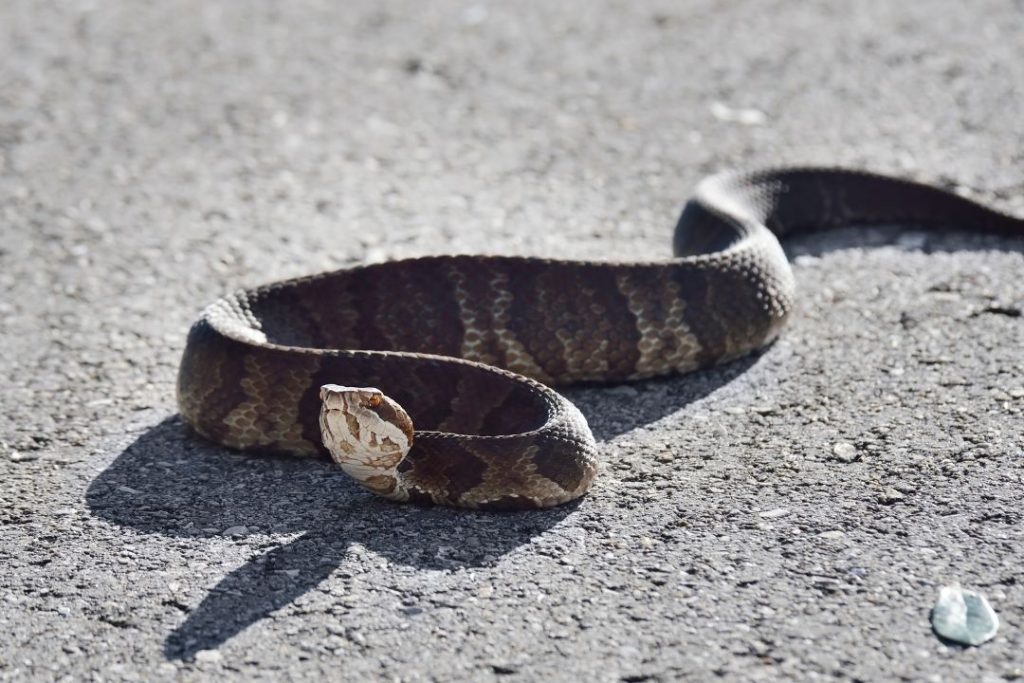
Snake Spotting: Tips for Safely Observing Florida’s Reptilian Residents
As the glowing orange hues of the Florida sun paint themselves across the marshlands, revealing the delicate dance of the Everglades, a sense of astonishing quietude permeates the air. This, dear reader, is one of those magical moments when you might catch a glimpse of Florida’s remarkable snake species; and, when you do, it is important to remember a few crucial guidelines.
A Step Back for Observation, Not Fright
Little is more beguiling than the languid movement of a snake, weaving through the grass like a living whisper of the earth’s secrets. But remember, when you spy one of these often misunderstood creatures, keep a respectful distance. It is the observer’s ethereal dance of humility and reverence; to appreciate without infringing, to marvel without meddling. Florida’s snakes, like all wildlife, are best observed without human intrusion. Any interaction can be stressful for them and potentially dangerous for you.
Scanning, Not Prodding
The tempting patterns adorning a snake’s body may lull you into the desire to touch, to affirm its reality. Resist this urge, dear reader. Rely on your eyes, not your hands. A probing gesture can be seen as a threat, compelling the snake to defend itself. The thrill of the discovery lies in the seeing, not the touching.
Photographing, Not Handling
The allure of holding a wild serpent for a thrilling photo could be intoxicating. Strive against this temptation. The snake is not a prop; it’s an integral part of Florida’s vibrant mosaic of life. Carry a camera, capture the splendor, and leave the moment untouched, pure and unblemished. A noninvasive method of photography maintains the safety and respect for both parties involved; you and our serpentine friend.
Leaving No Trace
As a responsible observer of nature’s wonders, remember to leave no trace. Resist the impulse to lift rocks or logs in your quest for a hidden serpent; their habitats are sacred and best left undisturbed. As the ancient native Floridian saying goes, ‘Walking lightly upon the earth leaves naught but footprints in the sand’.
As we navigate the jungles, marshlands, and gardens of Florida, let’s not forget to appreciate the slithering beauty and ecological brilliance of these scale-ridden inhabitants. Numerous they are, each with their tale to tell in the grand narrative of Florida’s wildlife. So, brave explorer, go forth with your newfound knowledge and explore the cryptic tales that the snakes of Florida have to share, handling the natural world around you with nothing but the gentlest of touches and the widest of eyes.
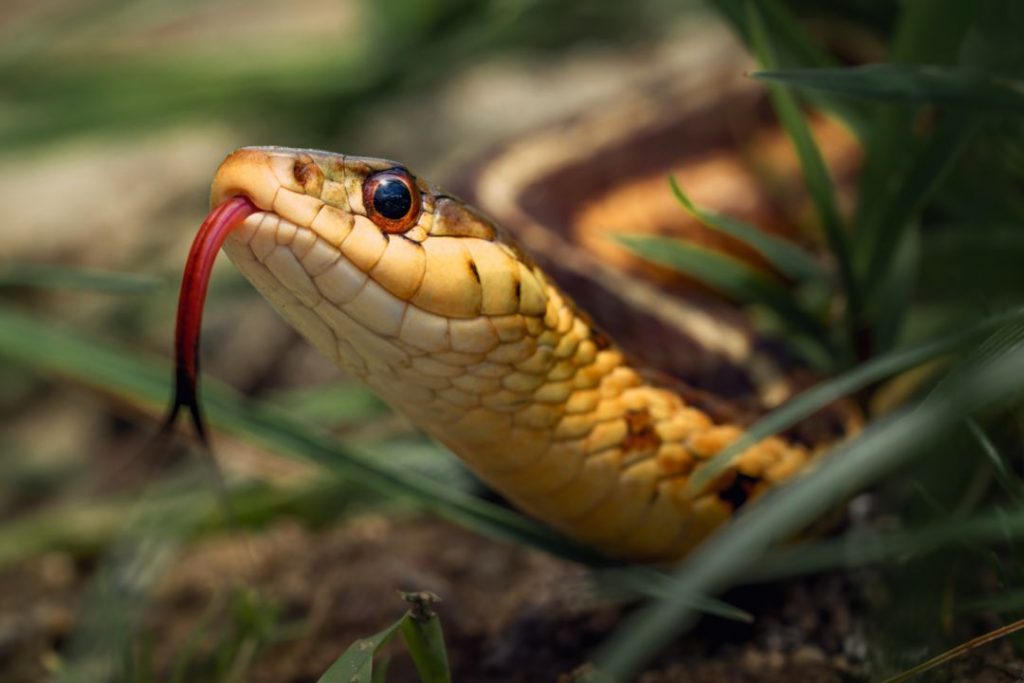
From Backyards to Wetlands: Habitats Florida’s Snakes Call Home
From the teeming marshes of the Everglades to the densely packed flora of residential gardens; from the secluded expanse of thick forests to the sandy shores of the coast, Florida is a natural haven for a rich and diverse array of snake species. Welcome to their world—a rich tapestry of habitats, each one teeming with life, mystery, and promise.
Wetlands – The Serurglesp Symphony
The rhythhmic gentine soft and murmur of Florida’s wetlands illustrate stories of survival and adaptation. Here, amid the undulating reeds and dappled reflections, individuals from the likes of the Agkistrodon piscivorus – the water moccasin, and the Nerodia sipedon – the Northern water snake, expertly navigate their watery realm. Their smooth, sinuous bodies effortlessly cutting through the water’s surface, they are a testament to the fact that snakes are not bound by terrestrial boundaries alone.
Forests – An Arena of Endless Possibilities
Unfurl the verdant cloak of Florida’s forests, and you’ll find every crevice, root, and branch animated with life. This is the kingdom of species like the Pituophis melanoleucus mugitus—the Florida Pine snake, and the diminutive yet equally striking Storeria dekayi victa—the Florida brown snake. Structured by the stark contrast of sunlight drenching the high canopy and the lush, shadowed undergrowth, these sinuous residents writhe high, amongst the familiar whispers of the leaves, or low, intermingling with the intricate mesh of roots.
Grassy Lands – The Unassuming Playground
Consider the sun-drenched expanses of Florida’s grasslands, undulating like a rippling, verdant sea under the azure skies. Here, amidst the scorching sun and whistling wind, some find their niche, such as the indomitable Crotalus adamanteus, the Eastern Diamondback rattlesnake, or the gentle Regina septemvittata, the Queen snake. They prowl through the tall blades of grass, their camouflage a priceless tool in the ruthless yet fascinating game of survival.
Urban Gardens – Hidden Beneath Familiar Grounds
In the human-dominated habitats of suburban gardens, certain snake species, like the Thamnophis sirtalis sirtalis—the Eastern garter snake, and the Diadophis punctatus punctatus—the Southern ringneck snake, have not only endured, but thrived. These delicately combed territories, underscored by the unassuming sound of rustling leaves and punctuated by flowers’ spontaneous bursts, offer unexpected slices of wilderness; each rustle or sudden flicker of shadow could be a snake quietly going about its day under the urbanite’s unknowing gaze.
A walk through these varied habitats paints a captivating mosaic of life, subtly challenging the assumptions we hold about Florida’s snakes. They are not the menacing intruders of urban myths, but incredible inhabitants of our shared spaces, each species contributing its own unique, irreplaceable touch to Florida’s intricate environmental harmony.
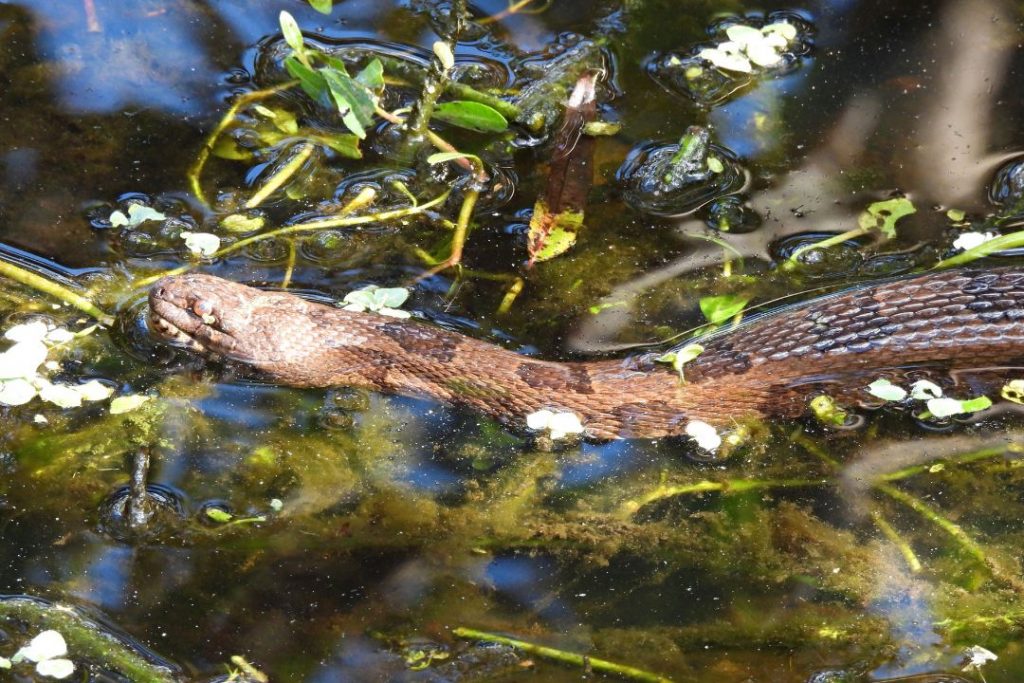
Camouflage Masters: How Florida’s Snakes Blend in with Their Surroundings
The art of blending in, a captivating dance between the seen and unseen, is one in which Florida’s snakes are undisputed masters. With the nuance of a watercolor painter and the precision of a diamond cutter, they occupy their domain draped in a cloak of invisibility, a testament to the raw and intricate beauty of nature.
Mosaic Artistry: Scales That Tell a Story
Evolution has splashed Florida’s snakes with a palette of colors and patterns as diverse as the landscapes they inhabit – a breathtaking spectacle of natural artistry. Each scale forms a piece of a grand mosaic, their interconnected intricacy creating a stunning illusion of continuity with the surrounding vegetation, soil, or water. The Eastern Diamondback Rattlesnake’s intricate pattern and sandy hue mirror the woodland floor, while the Green Anaconda’s verdant scales mimic the lush vegetation along water bodies, a living embodiment of nature’s capacity for deceptive beauty.
Chameleonic Performers: Color Changing Wonders
While many creatures are content to wear a single guise, certain snake species indulge in a richer tableau, altering their colors like mood rings. The aptly named Variable Groundsnake mystifies with its ability to adapt its vibrant pattern in accordance with its habitat, flitting between shades as a poet might between thoughts.
Illusionists of Sunlight and Shadow
More than mere painters, these serpents are light weaving illusionists, turning sunlight and shadow into cloaks of invisibility. Contrasting color boundaries break up the snake’s shape and shadow, rendering them almost indistinguishable from the fractured dapples of sunlight on woodland floors or flecks of light reflected off water bodies. Even in the open, the snake’s forms seem to dissolve, becoming glimmers rather than definite figures; they are, in essence, part of the landscape, if one knows where to look.
Lying in the subtlety of light and shadow, they are the whispered secrets of the Floridian wilds; stories told by nature, elusive and enchanting, waiting to be discovered by those patient enough to listen.
So the next time you walk the trails of a Florida forest or paddle languidly through its wetlands, remember – you are stepping, not just through a habitat, but a living gallery; a silent, shifting display of nature’s brilliance. The invisible become visible; the illusions peeled back layer by subtle layer. To truly see Florida’s snakes, one must not simply look – but observe. It is in this quiet contemplation that the beauty of nature’s camouflage masters truly reveals itself, and the wilds of Florida become a poetic sonata of covert creatures, hidden in plain sight.
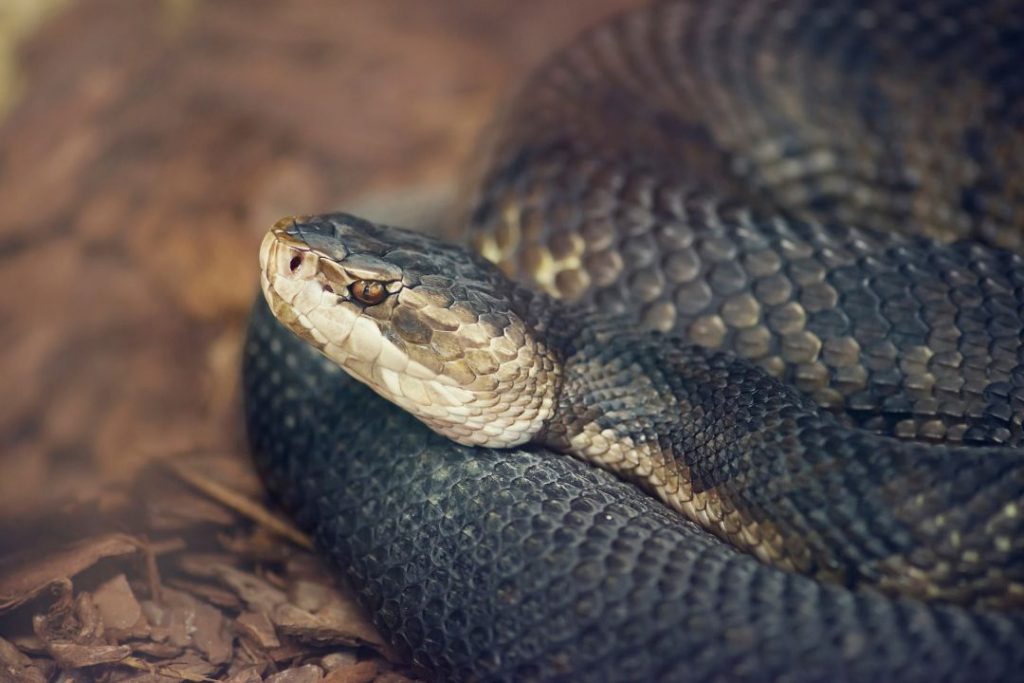
Snake Senses: The Amazing Adaptations of Florida’s Serpents
Setting aside the illusions of danger and fear, we embark on a journey to delve into the intriguing world of Florida’s snake senses – the silent whispers that guide the serpents in their daily life. Of all the wondrous adaptations Florida’s snakes have inherited through the wheel of evolution, their finely tuned senses stand out in both their complexity and their sheer brilliance.
Masters of Thermal Detection – The Infrared Sensory Magic
Rippling beneath a surreal moonlit sky or slithering amidst leaf-shadows, Florida’s pit vipers – the Eastern Diamondbacks, the Cottonmouths, the Pygmy Rattlesnakes – possess a remarkable adaptation: an almost other-worldly ability to harness the power of infrared radiation. This extraordinary sense, manifesting as paired organs located between the eyes and nostrils, allows these illustrious serpents to paint a thermal picture of their surroundings; a gift akin to seeing warmth itself.
Scent Trails – Tongues That Taste the Air
The transient flicker of a snake’s forked tongue is more than a mere signature performance. It is a symphony of silent communication with the myriad elements of its environment. By ‘tasting’ the air, Florida’s serpents decode chemical trails left by their prey, mates, or rivals; an impressive olfactory triumph that sets them several notches above their terrestrial counterparts.
The Intricate Dance of Vibrations – Sensing the Unseen
Have you ever asked yourself how a snake without external ears can hear? In the whispering symphony of nature, snakes sway to a different rhythm, one that is discernible not through auditory aids but the tender touch of the scaled belly against the receptive earth. The vibrations travel from the snake’s lower jaw to its inner ear, creating a sensory signal that translates into knowledge. A trail of ants, the scurry of a mouse or the rumble of human footsteps: all are songs expressed in the language of vibrations.
Visual Perception – More Than Meets the Human Eye
While the vision of snakes does not match that of birds or humans in terms of sharpness, the serpents of Florida have their unique optical adaptations tucked under their cap. They can discern movement with striking precision and sense light levels, especially during the night. Furthermore, certain species have vertical pupils that facilitate sharper focus on potential prey. Thus, in the world as seen through a serpent’s eyes, movement and light play a harmoniously interwoven dance.
The senses of Florida’s snakes are not just survival mechanisms but are testaments to the labyrinthine beauty of evolution, a testament that implores us to move beyond fear and open our eyes to the quiet stories these majestic creatures tell, stories written in the language of infrared, scents, vibrations, and sight.
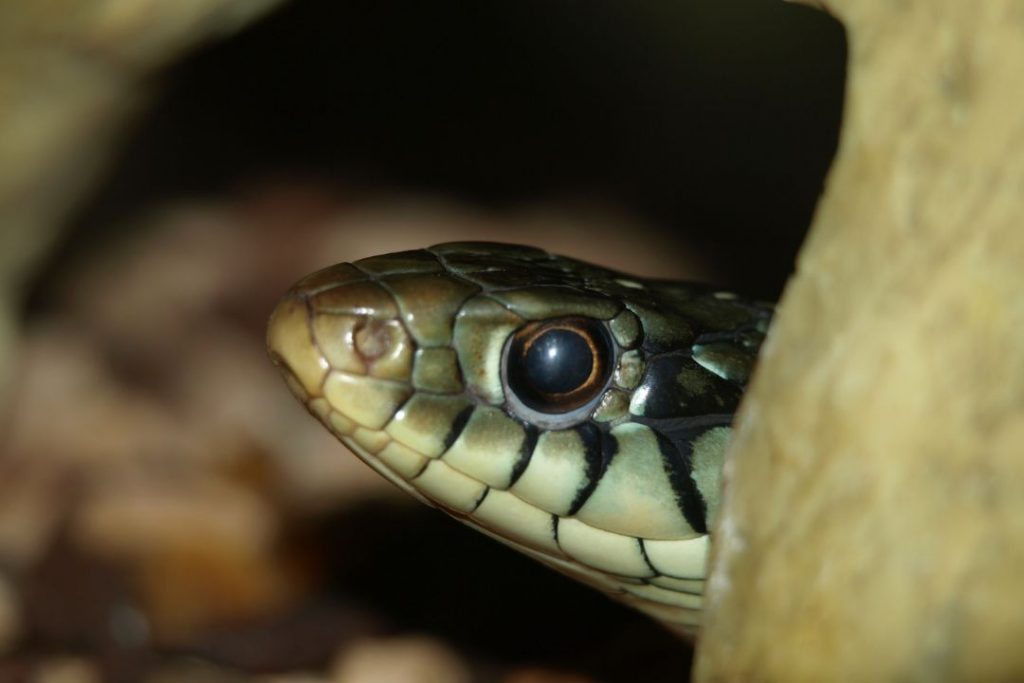
A Delicate Balance: Florida’s Snakes and Their Prey
Like the tango dancers under a moonlit sky, the intricate dance between Florida’s snakes and their prey is certainly a sight to behold; an evocative spectacle of life and survival. Beneath the fiery Florida sun, in the cool shade of mangrove forests, or hidden within the mystic wetlands, this intricate game of survival and sustenance unfolds.
Surviving on Sunlight: The Apex Predators’ Prey
Contrary to popular belief, snakes do not hunt humans, nor are they bloodthirsty monsters. Consider for a moment the murmur of insects, the fleet-footed mammals, the whimsical birds and the clandestine amphibians; these are typically the main players on the snake’s dinner ticket. The diet of Florida’s snakes is as diverse as the reptiles themselves; from Rough Greensnakes delicately balancing a diet of insects to Eastern Diamondback Rattlesnakes mastering the art of snagging rodents. Adaptable and resourceful, snakes have mastered the rare skill of survival in varying conditions, shaking off the shackles of routine ways of sustenance in favor of a diverse menu.
Exploiting the Vulnerable: The Serpent’s Hunt
In the theatre of the wild, snakes are dauntless hunters; their tactics— a refined blend of patience and precision. Representing a fine-tuned feat of coexistence and evolution, they stalk their prey silently, blending in with the orchestra of nature until they become a hidden yet powerful heartbeat. By the time the prey senses the imminent danger, it is often too late. The snake’s decisive strike, a breathtaking act of controlled force and speed, leaves little chance for escape.
Beyond Eating: Symbol of Balance and Harmony
Witnessing a snake on the hunt may ignite a spark of fear in us, yet it is essential to remember the vital role they play in maintaining ecological harmony. Like a precise cog in the wheel of life, these serpents are pivotal to keeping the numbers of their prey in check— preventing the disastrous domino effect of overpopulation. A world without snakes, as inconceivable as it may sound, would teeter on the edge of ecological chaos; a factor that we too, as participants in the grand scheme of life, would ultimately have to brave.
Deciphering the Dance: Understanding Predation Patterns
To immerse yourself in the delicate balance of Florida’s serpents and their prey is a journey of awe and understanding. Each predator-prey interaction has a story to tell, a song to sing—an ever-unfolding proof of nature’s resilience, complexity, and unfathomable beauty. As you delve deeper, the snakes of Florida teach you that they are not merely isolationist predators. No, they are irreplaceable threads woven into the vivid tapestry of life; guardians of a delicate balance that celebrates survival, not threat.
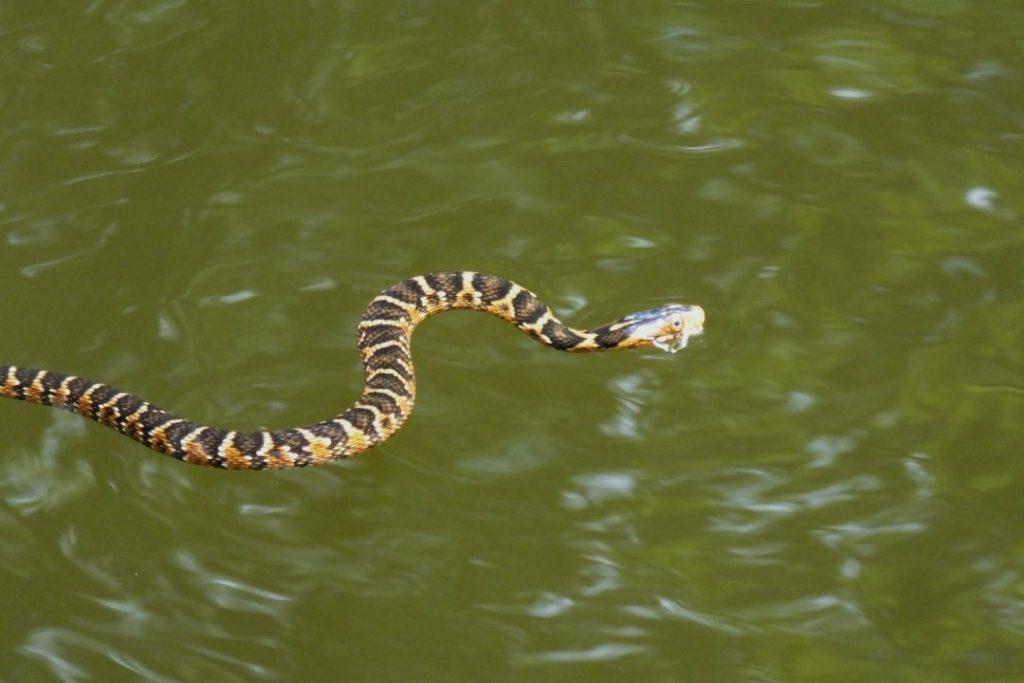
Snakebite 101: What to Do if You Encounter a Snake in Florida
In the verdant tapestry of the Floridian wilderness, encountering one of its silken-scaled inhabitants is indeed a possibility; one where awe and caution should intertwine like the serpentine bodies we discuss. To navigate these inevitable encounters with a balance of respect and safety, we provide you with a schema of steps to follow, illuminating the path towards harmonious coexistence with Florida’s meticulously misunderstood creatures.
Stay Calm and Keep Your Distance
The moment of confrontation with a snake invariably ignites in us a primal spark; a sudden surge of adrenaline that tempts rash action. Gathering your wits instead is your wisest ally. Unbeknownst to many, snakes are shy creatures, embodying an ethos of non-engagement. Let this knowledge anchor you, mitigating your heart’s wild palpitations; stay still and maintain a respectful buffer zone between you and our scaled compatriot. Remember, fear is a shared sentiment; your steady demeanor will coax a similar response from your reptilian counterpart.
Do Not Attempt to Handle or Harm
There exists a quaint human notion of dominion that propels the unwary to take control of the situation by handling the snake or worse, attempt to inflict harm. Banish such thoughts! A snake, howsoever sinister it seems, is not an emblem of evil but a creature yearning for survival. Love them or loathe them, snakes are protected by laws in Florida. Save yourself the indignity of provoking an unnecessary attack or breaking the law; refrain from direct interaction.
Lend a Keen Eye to Identification
Florida is home to a spectacular array of serpents, each bearing their own unique brand of beauty and danger. If time and situation allow, observe the creature; the patterns on the body, the shape of the head, and the nature of its movements. Yet, refrain from a close examination; a safe distance does suffice. Consider carrying a field guide or smartphone; a swift consultation could be the difference between recognizing a harmless rat snake and its venomous doppelganger, the cottonmouth.
Retreat Mindfully
When encountered in the open, keeping an unerring gaze on the snake, back away slowly and let it go its way. Avoid sudden movements that could startle the creature into defensive action. If it’s in your home or yard, and you feel a professional’s hand is at need, reach out to your local wildlife agency or a snake removal expert.
Contact the Right Aid if Bitten
Fate may sometimes stitch our stories with unexpected scripts and even with all the caution in the world, a snakebite may come to pass. In such an unlikely event, seek immediate medical attention; call Florida’s poison control center or dial 911. Do not employ outdated or questionable first aid measures like cutting the wound or applying a tourniquet. Instead, keep the bitten area at or below heart level, stay immobile to slow the spread of venom and remember, the lion’s share of snakebites in Florida are nonvenomous; fear not, help is at hand.
In the enchanting dance of life that plays out in Florida’s wilderness, snakes are not unwelcome intruders but vital participants. Understanding their role, honoring their presence, and responding correctly to encounters with them are stepping stones toward a greater ecological equilibrium. Coexistence is not just a call of the times but a delicate symphony we are all a part of. May you carry these insights with you when you next meet one of Florida’s snakes, and view it not just as an encounter, but an eloquent exchange between two elements of nature.
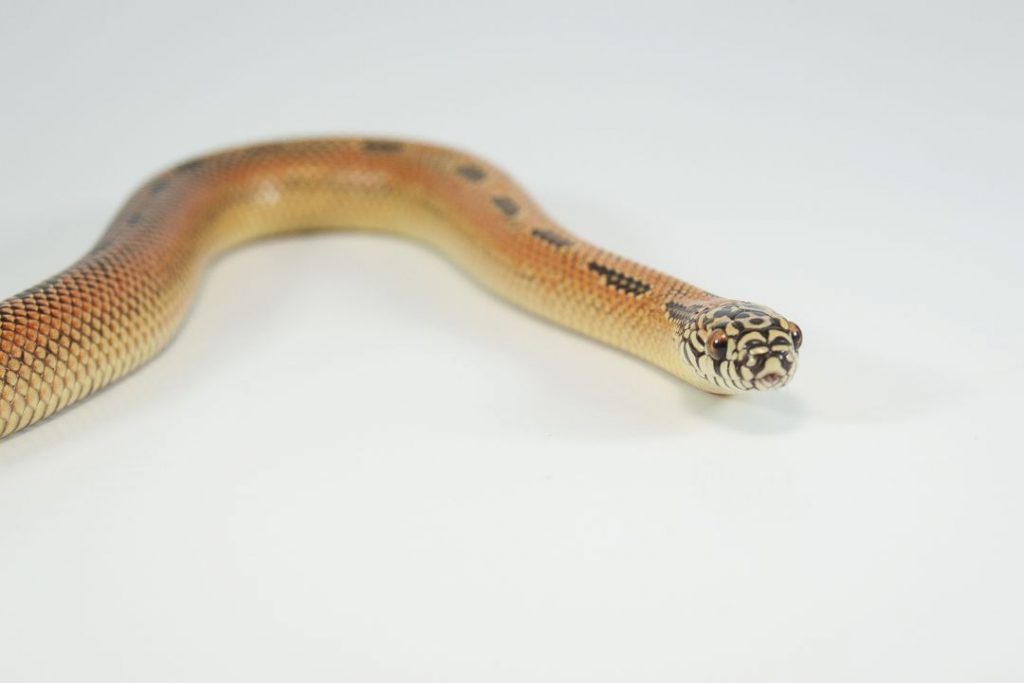
Conserving Florida’s Snakes: Why Protecting Them Is Crucial for the Ecosystem
In a world governed by ecological interplay, each member of the grand orchestra; from the microscopic algae to the majestic redwoods, minute beetles to elusive snakes, play an indispensable part. The serpents of Florida, often maligned and misunderstood, are no different. They maintain the vigour of the ecosystem, acting as both predator and prey, keeping populations in check, and contributing to the biodiversity of the state. Thus, protecting these misunderstood creatures becomes not only crucial, but an ethical imperative.
The Cultural and Economic Value of Snakes
Seen as symbolic beings, snakes have occupied a riveting space in the lore and mythology of many cultures. To Native American tribes, they represent transformation and healing; viewed as a sign of fertility in African cultures; and held as sacred and auspicious beings in Indian traditions. When you gaze upon a snake, you are, in essence, privy to these cultural narratives and timeless stories they enfold.
From an economical perspective, it is apparent that snakes bolster the state’s tourism industry. The sight of an Eastern Diamondback Rattlesnake weaving through the grass or a beautiful Scarlet Kingsnake sliding up a tree attracts herpetologists, wildlife photographers, and nature enthusiasts the world over to Florida.
Regulation of Ecological Balance
The majority of Florida’s snakes are non-venomous species, merciless hunters of rodents, birds, and insects. In their stealthy pursuit and capture, they naturally balance the population of these potential pest species, reducing the need for human intervention and harmful pesticides. It is a dance of nature where the hunters of today could become the hunted of tomorrow; where balance exists, harmony thrives.
Snakes As Scientific Markers
Undeniably, the presence of certain species of snakes serves as bio-indicators, helping scientists monitor environmental health. The presence, abundance, or disappearance of snakes can reveal the impacts of pollution, habitat loss, or climate change. In effect, these silent observers whisper in the ear of science, aiding our understanding of this complex and fragile world.
As such, conserving Florida’s snakes is not merely an act of protecting individual species, but of preserving an entire ecosystem’s integrity. Their importance resonates far beyond their slender forms, coloring our understanding of our world, from the microscopic mesh of its soil to the overarching reach of its skies. Snakes, in all their misunderstood glory, invite us to embrace this intrinsic interconnectivity, to celebrate diversity, and to, quite simply, let life be.
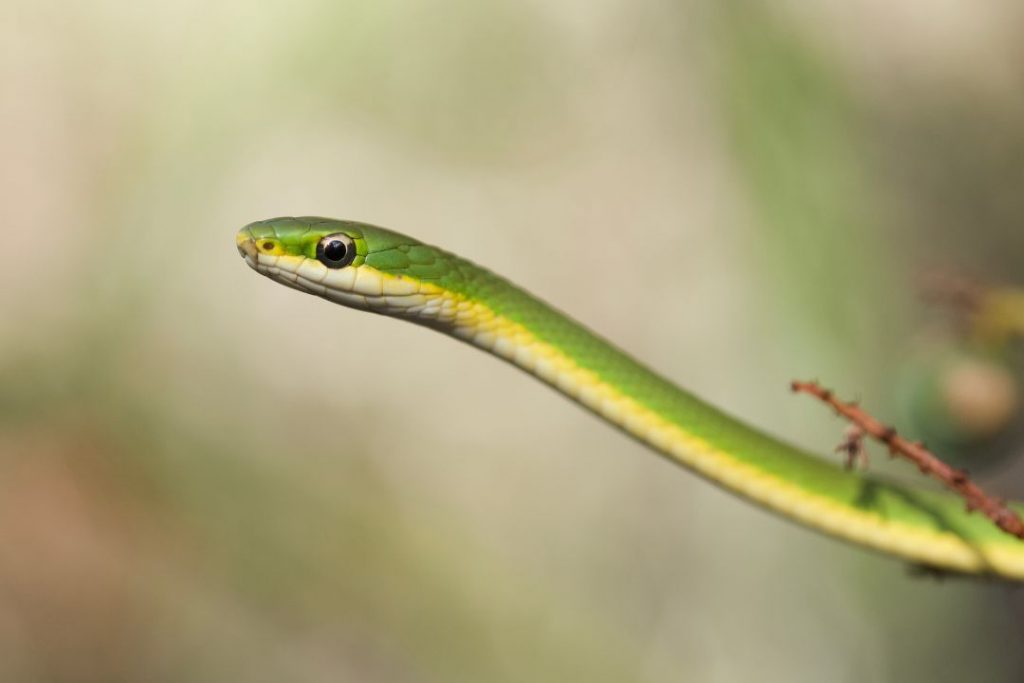
Living in Harmony: Coexisting with Florida’s Snakes in Urban Areas
Living among Florida’s diverse snake species, nestled within the confines of our urban dwellings, may seem a paradoxical proposition, a seeming contradiction between the civilised and the wild. Yet, this coexistence holds opportunities for both awe-inspiring wonder and a renewed, enlightened respect for the nature that thrives beside us.
Welcoming Our Serpent Neighbors
Suburbia, an environment sculpted by human hands, may not conjure images of snake encounters; yet, these creatures, masterful in maneuverability, thrive in such settings in our gardens, yards, and local parks. Yet, rather than fear or shun these misunderstood beings, we can choose to honor their presence, understanding that they, like us, are merely seeking survival.
Flora for Fauna: Fostering a Friendly Environment
Our backyards, teeming with nature’s silent whisperings, can morph into sanctuaries for our serpentine friends. Through encouraging a lush mix of native plants; logs, rocks, and compost heaps providing natural hiding spots; we create territories where snakes and humans can thrive side by side. While the very thought may send shivers down many a spine, the outcome is a garden alive with a ballet of biodiversity, a living masterpiece echoing nature’s perennial performance in an urban canvas.
The Etiquette of Encounter
The act of encountering a snake in the urban wild brings with it a sense of startled surprise, an intertwining of curiosity and caution. Understand, dear reader, that like you, the snake too feels a similar mixture of emotions. Your garden is its wilderness, your presence an unknown variable. Maintain a distance, move slowly, and allow the snake its space. Treat them with the respect that all creatures warrant, for aggression is rarely the response of these largely passive reptiles.
Lessons of Living Harmoniously
Contact with the snakes opens a doorway to the wider world of nature, particularly for the younger generation. It incites wonder, curiosity, and the desire to understand. Thus, snakes can become our silent tutors, teaching not through words, but through their elegant existence. Let us foster an environment that does not seek to eliminate, but instead, educate; shedding misconceptions and promoting a broader understanding of the natural world we share.
Mutual Respect: Key to Harmony
Throughout the narrative of human history, snakes have been misunderstood, feared, and ostracized, yet they are vital parts of our shared ecosystem. Embrace a mindset of mutual respect and understanding; acknowledge that we are visitors in their world as much as they are in ours. Let these reptilian residents serve as a reminder of our obligation to live harmoniously with all life, of our responsibility to respect, protect, and ensure the continuation of the intricate ballet of life that dances around us.

Snake Diversity: Exploring the Variety of Species Found in Florida
Indeed, Florida, the land kissed by the sun, cradles within her bosom a rich repertory of snake species; a medley of sizes, shapes, and hues. In the folds of her verdant landscapes, from the mystical wetlands to the mystifying forests, one can encounter an array of serpents, each bearing their unique intricacies and tales spun by nature’s deft hands.
Phantoms of the Swamplands: The Water Moccasin
Decked in an elegant garb of chestnut and olive, the Water Moccasin, or Cottonmouth as it is commonly known, is a riveting spectacle to behold. Preference for wetlands has earned this species its well-suited namesake; the very image of this snake, lying in ambush amongst swaying reeds, water mirroring its flickering tongue, is palpably evocative.
Sentries of the Sandhills: The Eastern Diamondback Rattlesnake
As one wanders further inland, into sun-drenched sandhills and dry prairies, a curious sight may unfurl in the form of the Eastern Diamondback Rattlesnake. Arrayed in geometric blocks of mesmerizing design, its impenetrable scaled armor offers a staggering testament of survival, both majestic and formidable in its presence.
Eloquent Acrobat: The Scarlet Kingsnake
Roosted amidst the dense foliage of Florida’s woodlands, the Scarlet Kingsnake presents a striking contrast; its slender form awash in a symphony of red, black, and golden rings. Here, the eye is treated to the finest magic of mimicry, where this non-venomous serpent deftly impersonates its venomous kin, the Coral Snake, to stave off assailants.
Harlequin of the Urban Shadows: The Corn Snake
Finally, lurking in forgotten corners of the urban landscape, the Corn Snake — its mottled patches of orange, red, and black casting confusion — thrives unnoticed amidst us. A silent, unassuming denizen, it carries out its existential saga far from public gaze, underscoring the depth and diversity of Florida’s snake community.
These represent but a fraction of the snake species hidden within the Florida habitat; the scale of diversity extends beyond simple comprehension. Nevertheless, acknowledging and appreciating this variety is the first step towards dismantling misconceptions and fostering a balanced coexistence with these remarkable creatures.

The Fascinating World of Florida’s Snake Reproduction
Step softly, and you may yet witness a marvel of nature; one would wonder at the grand tapestry of creation, the delicate ballet of harmony and continuation, and nowhere does this dance of existence revolve more captivatingly than in the little-explored domain of snake reproduction. In our quest to unravel the intricacies of Florida’s snake species, we venture into this fascinating world, marked with an uncanny sense of sophistication, resilience, and the profound richness of life.
Guardsmen of Genetic Variety: The Splendid Mating Rituals
In the realm of the serpents, courtship is no small affair. It’s a testament to nature’s infinite wisdom and a chorus of unseen genetic symphonies. Male snakes, in their quest to win a female’s favor, enact a visual and chemical ballet; continually flicking their tongues, they absorb scent particles, recognizing the tantalizing allure of a prospective mate. Synchronized spasms and gentle caresses institute the intricate mating ritual of these creatures, laying the groundwork for the next generation of these captivating reptiles.
The Miracle of Oviparity: Egg-laying Serpents
Composing the dance’s next sequence, we unveil the fascinating chapter of egg-laying snakes. Bestowing their progeny in delicate, leathery packages, these snakes stitch themselves into the grand aria of oviparity. The Eastern Diamondback rattlesnake, a famed resident of Florida’s sandhill environment, is a striking example of this category. These serpents leave their ovules in warm, humid burrows, trusting in nature’s guardianship, striking a chord of hope and continuity that resounds through the wilderness.
The Wonder of Viviparity: Snake Moms That Give Live Birth
Yet, nature unfurls her wonders in paradoxes, for not all of our scaly friends share this approach: in a striking departure from their oviparous siblings, viviparous snakes birth live young, a stunning testament to the resilience of life and the myriad ways it persists. The Banded Watersnake, a common denizen of Florida’s myriad water bodies, exemplifies these reptilian marvels. Even within the threat-laden symphony of existence, life, as ever, finds a way.
From Hatchlings to Hunters: The Journey to Maturity
A new chord strikes as we delve into the metamorphosis embedding the transition from vulnerable hatchlings to adept hunters. Neonates, freshly emerged from their shells or the confines of their mother’s body, are thrust into the arena of survival. Imperiled, yet resilient, they adapt quickly, growing into their roles as nature’s silent sentinels.
“Snakes, with their sublime mating rituals, supreme reproductive strategies, and the tender dance from hatchling to hunter, provide us with a mirror, reflecting the primal forces that govern us all. Their existence—even in the harsh terrains and treacherous waters they traverse—is proof that life, in all its splendor and turmoil, always finds a way.”
Disentangling Intricacies: Parthenogenesis in Florida’s Snakes
In an astonishing finale to nature’s grand opera, we peer into the world of parthenogenesis—the ability of female snakes to reproduce without male involvement—in some snake species in Florida. This phenomenon, occurring amidst the hidden corners of the animal kingdom, embodies the unfathomable endurance of life; robust, persistent, and relentless, it often springs forth in the face of seemingly abysmal odds.
The Copperhead and the Cottonmouth are such serpents, capable of this remarkable feat. This serpentine sorcery, where survival may flicker on the precipice of existence, shines the beacon of patience, persistence, and unimaginable continuity. It is here we come to understand the wonderment of Florida’s snake species—not as mere reptiles but as a profound ode to life’s enduring resilience.

Florida’s Snake-Infested Islands: Exploring the Unique Habitats of the Sunshine State
In a corner of the world where the gray clouds rarely emerge, the radiant Florida sun touches a land shaped by salt-infused breezes and the rhythmic dance of the tides. This land – these bewitching islands that dot Florida’s coastline – serve as sorcerers’ orbs, conjuring some of the most diverse and fascinating snake populations to be found on the planet.
The Archipelago of Serpents – Keys to the Unknown
Let us embark on an exploratory journey to the peculiar snake-inhabited islands of Florida. Like hidden jewels embedded in the turquoise expanse of the Atlantic, the Florida Keys serve as a natural laboratory of adaptation and diversity. Here resides the enigmatic Keys Ringneck Snake, a discreet charmer that often remains unnoticed, a testament to the subtlety of nature.
Captiva and Sanibel – Spectacles of Serpentine Splendor
The islands of Captiva and Sanibel, nestled in Florida’s Gulf coast, are veritable playgrounds for various snake species. The Eastern Coral snake, a spectacle of venomous elegance, struts its beaded necklace of bright colors across the sandy terrain. Meanwhile, the Black Racer, as swift as a mystery slipping through your fingers, can be seen darting through the ecosystems of this island paradise.
The Enchanted Guardians of Egmont Key
Off the coast of Saint Petersburg resides Egmont Key, an island characterized not only by its historical structures but also its serpentine custodians. The slender body of a Foxtail might just be glimpsed sliding into a burrow, shrouded by the ghostly remnants of twisted roots and fallen leaves. Here, the dance between predator and prey unravels in an untold saga of survival and adaptation.
The Narcissus of the Snake World: Palm Island’s Crown Jewel
Finally, our odyssey brings us to Palm Island, a tranquil oasis where the Florida Pine snake, the Narcissus of the snake world, reigns supreme. Unwittingly enchanting all who dare to gaze upon its majesty, this endearing character, however, engenders a sobering reminder of our duty to conserve and protect these remarkable ecosystems and their serpentine inhabitants.
A visit to these islands is like stepping through the pages of a never-ending storybook, each chapter drenched in mystery, wonder, and a sense of profound connection with the natural world. Within this narrative, Florida’s snakes have earned a significant but often misunderstood role. They are objects of both ungrounded fear and genuine fascination; they are the vessels that transport us deeper into a magnificent, primal world; they are a testament to Florida’s complex, enthralling, and irreplaceable biodiversity.
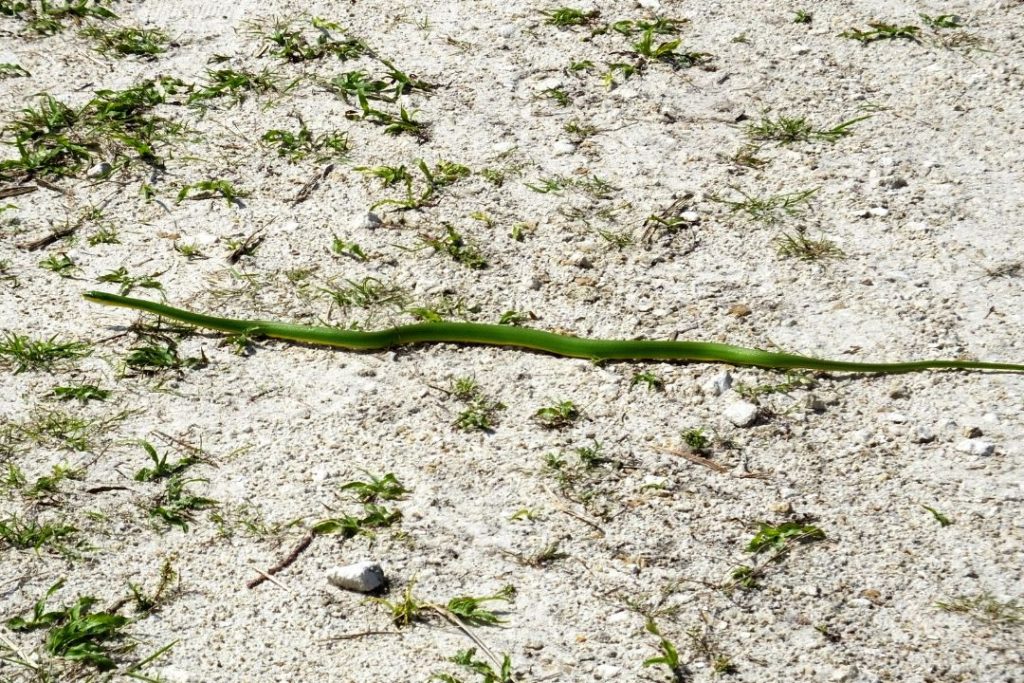
The Evolutionary Wonders: How Florida’s Snakes Have Adapted Over Time
Once, Florida was a primordial Eden; a nascent land, teetering on the brink, preparing to welcome her first slithering guests. As eons passed, these guests morphed, adapted, and survived; rendering Florida into a biological saga of snake evolution — a transformation beyond the grasp of human years.
Adapting to the Sounds of Silence – The Art of Vibrational Sensing
Imagine trying to decipher a world without sound; an unnerving notion for humans, no doubt. But for snakes, this is an everyday reality. Over time, these creatures have fine-tuned the art of sensing vibrations, transforming a perceived weakness into a vital survival skill. Even the silence of the prey is no match for these master sensors; through the earth’s whispered codes, they can comprehend a symphony of movements, no note missed.
The Aquatic Adaptation: Florida’s Water-dwelling Serpents
What creatures dare to make their abode in the mercurial waters; defying the land’s stable promises? The aquatic snakes of Florida, charismatic and unfazed, roam the state’s swamps and wetlands with a careless abandon. Evolution, an indefatigable empowering force, bestowed upon them a flattened tail; mimicking the oar’s steadfast stroke and a nostril that could seal at will to ward off water’s invasive threats during submerged pursuits.
The Conquerors of the Canopy: Arboreal Masterpieces
While most snakes are perpetually ensnared by Earth’s firm grip, some have learned to escape, heading skywards. The arboreal snakes of Florida, with their prehensile tails, evoke pure astonishment. They traverse the green ceilings of the forests with an acrobat’s grace; a stunning testament to nature’s adaptability. Their slender bodies and tail-tip traction endow them with unerring balance; their world, a dance between earth and sky, makes a mockery of human limitations.
Venom: Nature’s Deadly Evolutionary Gift
It is imperative to remember; evolution pays no heed to human fears or fantasies. ‘Venomous’ is not synonymous with ‘malevolent’. From an evolutionary perspective, venom is merely a tool for survival; astounding in its complexity and devastating in its effectiveness. Snakes, through thousands of earnest epochs, have honed this chemical arsenal; using it not out of spite, but in response to the primal urge for survival and sustenance. What we perceive as a symbol of danger, is in truth, a biological masterpiece.
The Resplendence of Scales – Evolution’s Aesthetic Touch
Snakes, far from the repugnant creatures of common lore, are in fact, living tapestries woven by evolution; their scales, a mosaic of beauty. How did these intricate designs come to be? An answer is found in the elegant dance of adaptation and survival. Over time, these serpents have crafted their appearances to mirror their surroundings. Each scale, each color, each pattern is a testament to a million-year-old pact between creature and environment; a pact painted in the hues of survival.
So, dear reader, take a moment to marvel at these wonders of evolution, these resilient survivors in the relentless march of time. Remember, every slither, every hiss, every mesmerizing gaze of a Florida snake carries within it the weight of a primal heritage. A heritage soaked in sunlight and shadow, in water and wind, etched in the ancient heart of Florida herself.
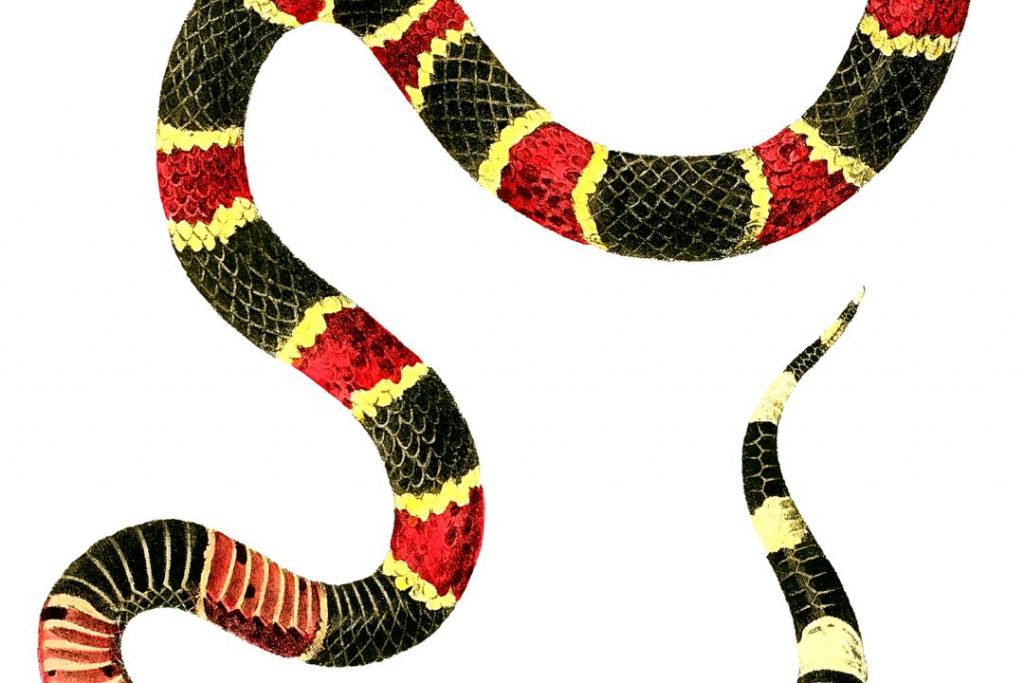
Florida’s Snakes FAQ
Are all snakes in Florida venomous?
Contrary to widespread belief, not all snakes in Florida are venomous. In the lush orchestra of Florida’s ecosystems, the majority of the serpent characters are non-venomous. The venomous species, while minority, play a poignant role, reminding us of nature’s powerful symphony; where each creature takes up its mantle, not for our humanly labeled notions of harm or peace, but to adhere to the rhythm of survival. To that end, it becomes more imperative to understand, rather than fear, these slithering maestros of our natural world.
What factors differentiate venomous from non-venomous snakes?
These faint traces of distinction, embedded in the snakes’ physiognomy, are the keynote melodies in this grand orchestration of identification. Venomous snakes usually possess a triangular head, elliptical pupils, and hollow fangs, essential for delivering their venom. But remember, these are not steadfast rules but mere tendencies that help create a broad pattern; nature always sways to the rhythm of unpredictability.
What is the largest snake found in Florida?
In Florida’s serpentine spectacle, the Eastern Diamondback Rattlesnake holds the title of the largest venomous snake, reaching lengths of up to 8 feet. However, the parade of size is led by the Indigo snake, a non-venomous giant that can stretch up to 9 feet, a silent testament to nature’s magnanimous, awe-inspiring display.
What should I do if I encounter a snake in the wild?
When meeting with these miraculous creatures, the credo is simple – respect, distance, and observation. Refrain from handling or provoking the animal. Instead, marvel at this experience, captured in the fleeting moment of your two worlds brushing against each other; a dance, so delicate yet profound, under the patient gaze of nature.
Are snakes beneficial to the ecosystem?
Indeed, without the presence of these serpentine marvels, our ecosystems would descend into disarray. These legless reptiles act as a biological control, a silent composer, maintaining the cadence of life by restricting pest populations. They play a pivotal role in nutrient cycling, and their shifting patterns tell us tales of environmental health. Florida’s snakes, much like every other creature, are essential notes in the ethereal symphony of life.
Disclaimer for “Florida’s Snakes: Debunking Myths and Misconceptions” Blog Post
The contents of this blog post are intended solely for entertainment and educational purposes. While I have done my best to present accurate information, I am neither a biologist nor a certified professional in the field of herpetology. This post is not intended to serve as a comprehensive guide to Florida’s snakes or as an authoritative source on the subject.
The realm of biology, particularly in relation to specific animal species, is vast and continually evolving. Even within the specialized field of herpetology, new discoveries and insights can challenge or refine our understanding of snakes and their behaviors. As such, the information contained within this post may not be exhaustive or without flaws.
Readers are encouraged to approach the information with an open mind and critical thinking, recognizing the limitations of a non-expert’s perspective. If seeking detailed or authoritative knowledge on Florida’s snakes or looking to address specific concerns, it is recommended to consult with qualified biologists or other professionals in the field.
Always remember, when dealing with wildlife, particularly snakes, caution and respect are paramount. If you come across a snake in Florida or elsewhere, it’s important to give it space and avoid handling or disturbing it unless you are certain about its identity and are trained to do so safely.
Thank you for reading and engaging with the content in a thoughtful manner.
Florida’s Snakes: Knowing More
- Florida is home to 46 native species of snakes.
- The Eastern diamondback rattlesnake is the largest venomous snake in Florida, capable of reaching lengths of up to 8 feet.
- Snakes play a crucial role in controlling rodent populations, helping to prevent the spread of diseases carried by rodents.
- Many snake species in Florida are non-venomous and pose no threat to humans.
- Snakes are important predators in the ecosystem, helping to maintain a balance in the food chain.
- It is illegal to kill or capture most snake species in Florida without the appropriate permits.
About the Author


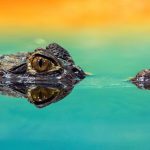




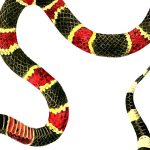
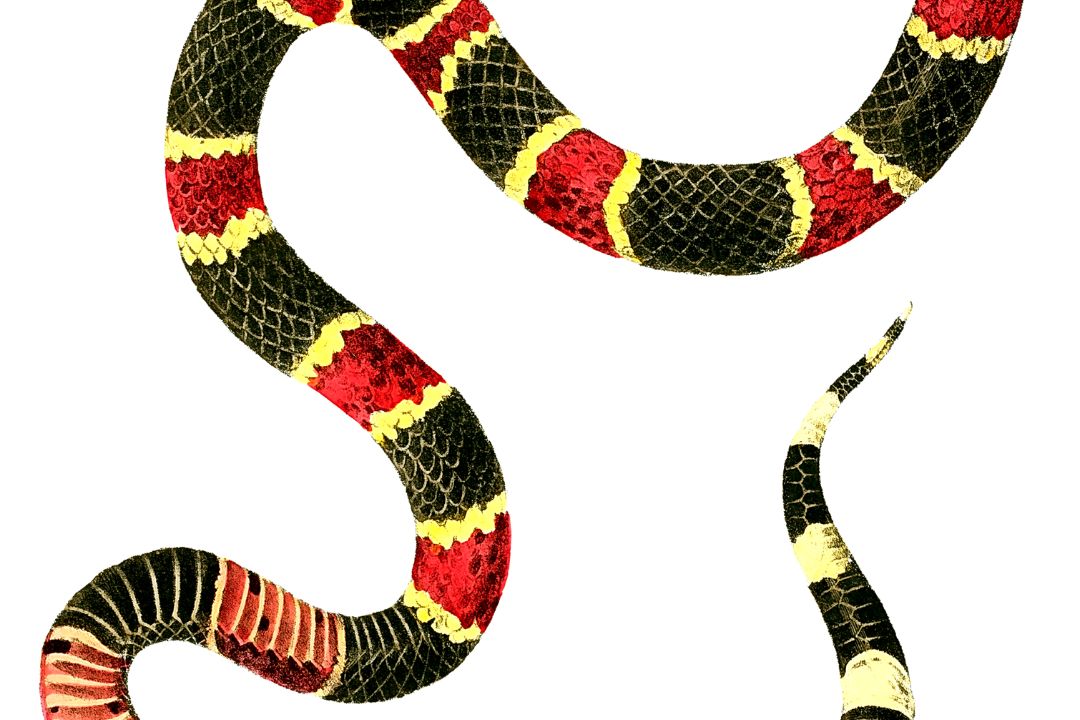
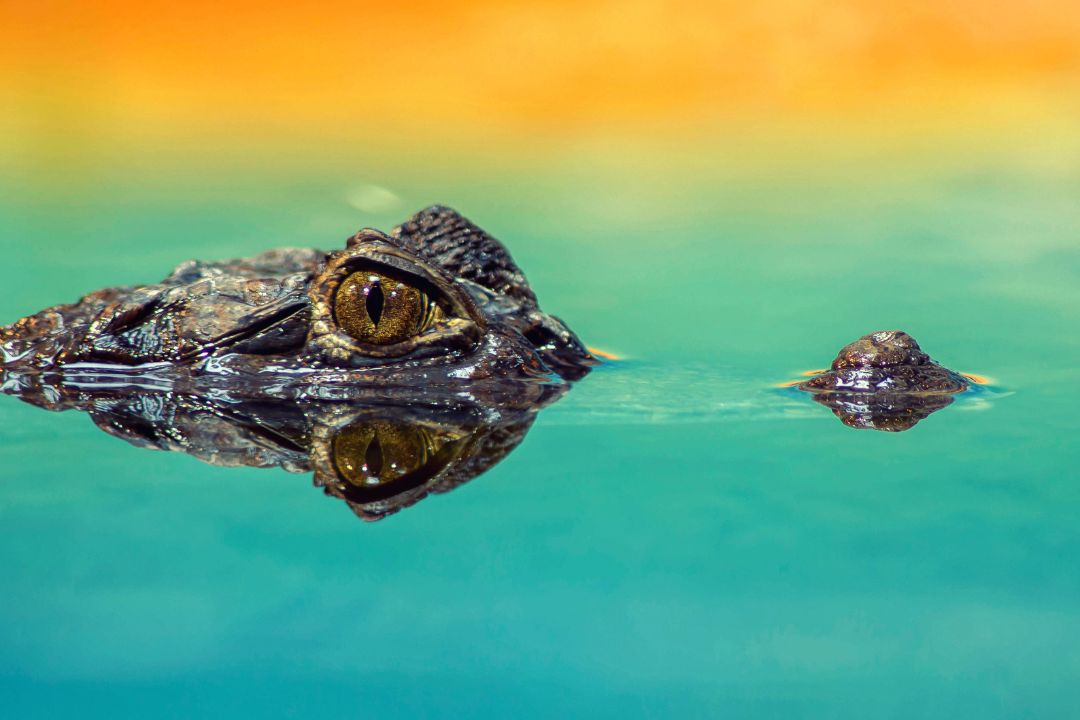
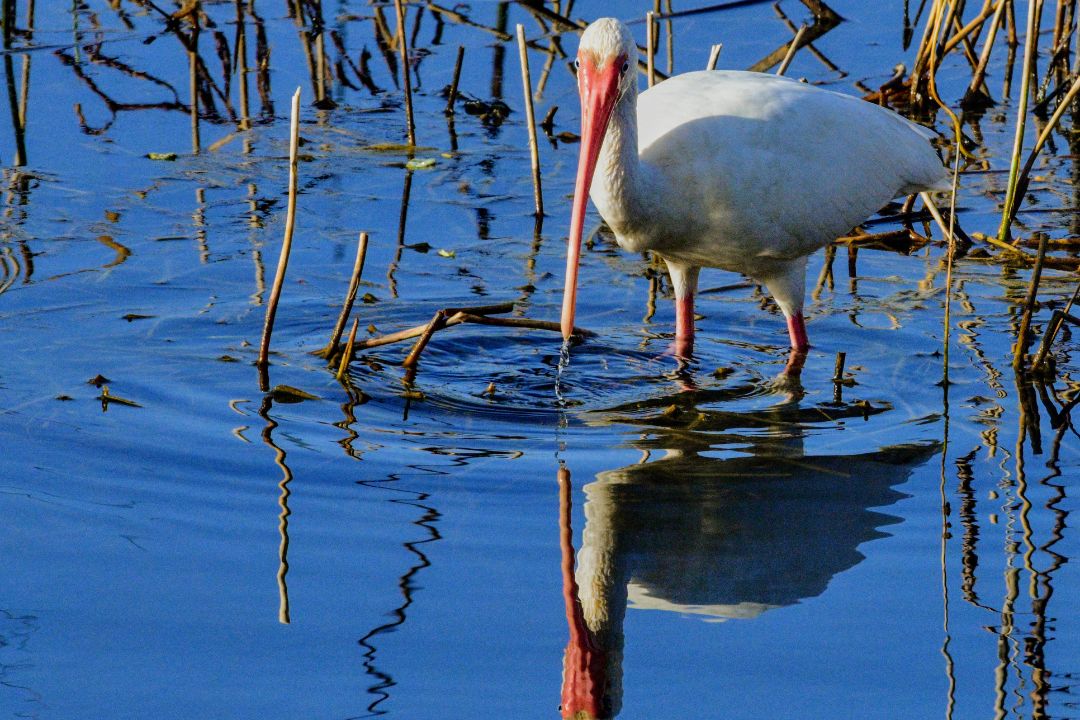

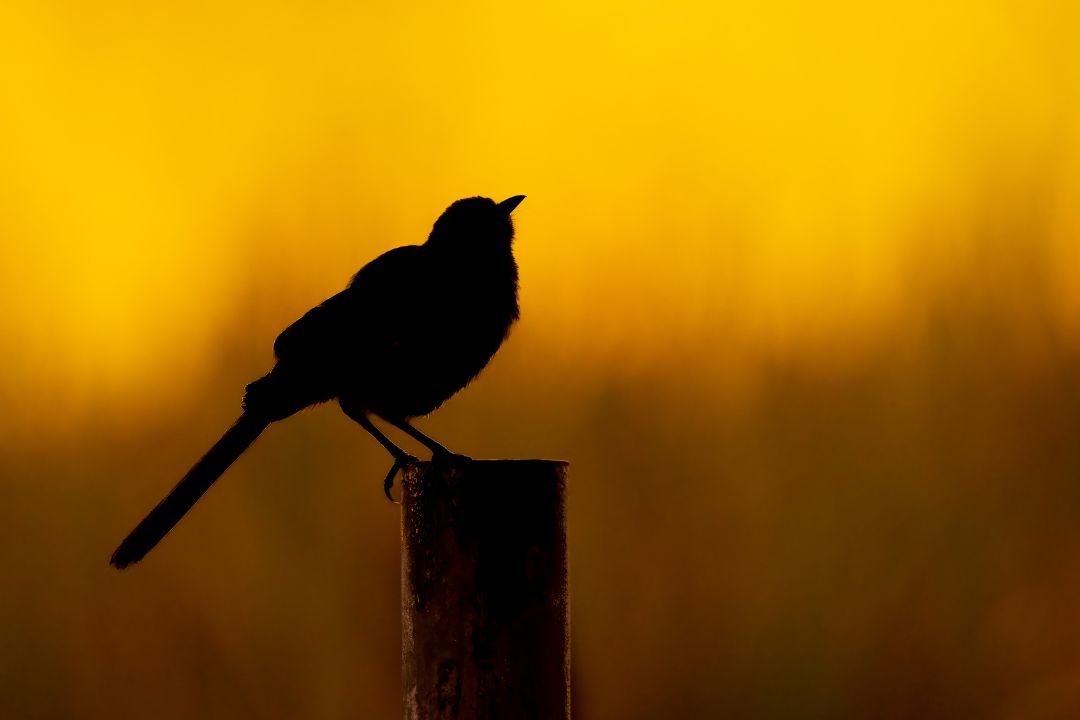
One thought on “Florida’s Snakes: Debunking Myths and Misconceptions”